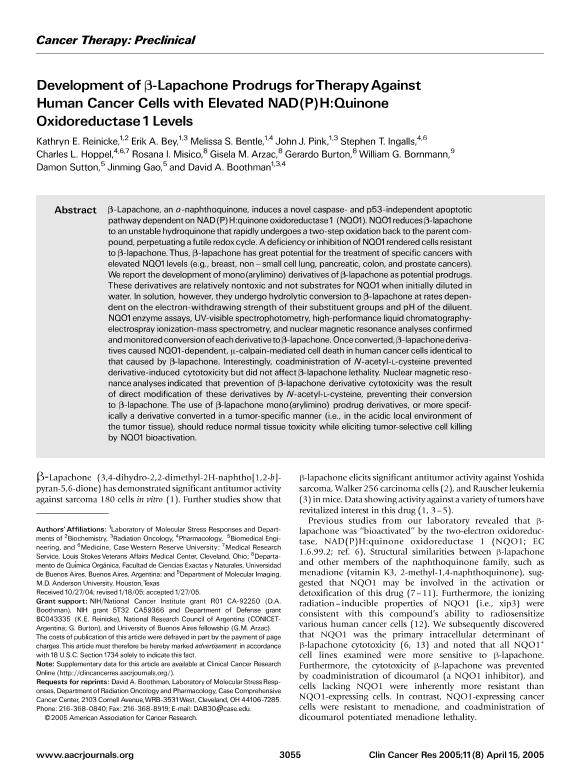Artículo
Development of β-Lapachone prodrugs for therapy against human cancer cells with elevated NAD(P)H:quinone oxidoreductase 1 levels
Reinicke, Kathryn E.; Bey, Erik A.; Bentle, Melissa S.; Pink, John J.; Ingalls, Stephen T.; Hoppel, Charles L.; Misico, Rosana Isabel ; Arzac, Gisella M.; Burton, Gerardo
; Arzac, Gisella M.; Burton, Gerardo ; Bornmann, William G.; Sutton, Damon; Gao, Jinming; Boothman, David A.
; Bornmann, William G.; Sutton, Damon; Gao, Jinming; Boothman, David A.
 ; Arzac, Gisella M.; Burton, Gerardo
; Arzac, Gisella M.; Burton, Gerardo ; Bornmann, William G.; Sutton, Damon; Gao, Jinming; Boothman, David A.
; Bornmann, William G.; Sutton, Damon; Gao, Jinming; Boothman, David A.
Fecha de publicación:
04/2005
Editorial:
American Association for Cancer Research
Revista:
Clinical Cancer Research
ISSN:
1078-0432
Idioma:
Inglés
Tipo de recurso:
Artículo publicado
Clasificación temática:
Resumen
β-Lapachone, an o-naphthoquinone, induces a novel caspase- and p53-independent apoptotic pathway dependent on NAD (P) H:quinone oxidoreductase 1 (NQO1). NQO1 reduces β-lapachone to an unstable hydroquinone that rapidly undergoes a two-step oxidation back to the parent compound, perpetuating a futile redox cycle. A deficiency or inhibition of NQO1 rendered cells resistant to beta;-lapachone. Thus, β-lapachone has great potential for the treatment of specific cancers with elevated NQO1 levels (e.g., breast, non - small cell lung, pancreatic, colon, and prostate cancers). We report the development of mono(arylimino) derivatives of β-lapachone as potential prodrugs. These derivatives are relatively nontoxic and not substrates for NQO1 when initially diluted in water. In solution, however, they undergo hydrolytic conversion to β-lapachone at rates dependent on the electron-withdrawing strength of their substituent groups and pH of the diluent. NQO1 enzyme assays, UV-visible spectrophotometry, high-performance liquid chromatography-electrospray ionization-mass spectrometry, and nuclear magnetic resonance analyses confirmed and monitored conversion of each derivative to β-lapachone. Once converted, β-lapachone derivatives caused NQO1-dependent, μ-calpain-mediated cell death in human cancer cells identical to that caused by β-lapachone. Interestingly, coadministration of N-acetyt-L-cysteine prevented derivative-induced cytotoxicity but did not affect β-lapachone lethality. Nuclear magnetic resonance analyses indicated that prevention of β-lapachone derivative cytotoxicity was the result of direct modification of these derivatives by N-acetyl-L-cysteine, preventing their conversion to β-lapachone. The use of β-lapachone mono(arylimino) prodrug derivatives, or more specifically a derivative converted in a tumor-specific manner (i.e., in the acidic local environment of the tumor tissue), should reduce normal tissue toxicity while eliciting tumor-selective cell killing by NQO1 bioactivation.
Palabras clave:
B-LAPACHONE DERIVATIVES
,
APOPTOSIS
,
BREAST CANCER
,
NQO1 (DT-diaphorase)
Archivos asociados
Licencia
Identificadores
Colecciones
Articulos(UMYMFOR)
Articulos de UNID.MICROANAL.Y MET.FISICOS EN QUIM.ORG.(I)
Articulos de UNID.MICROANAL.Y MET.FISICOS EN QUIM.ORG.(I)
Citación
Reinicke, Kathryn E.; Bey, Erik A.; Bentle, Melissa S.; Pink, John J.; Ingalls, Stephen T.; et al.; Development of β-Lapachone prodrugs for therapy against human cancer cells with elevated NAD(P)H:quinone oxidoreductase 1 levels; American Association for Cancer Research; Clinical Cancer Research; 11; 8; 4-2005; 3055-3064
Compartir
Altmétricas



